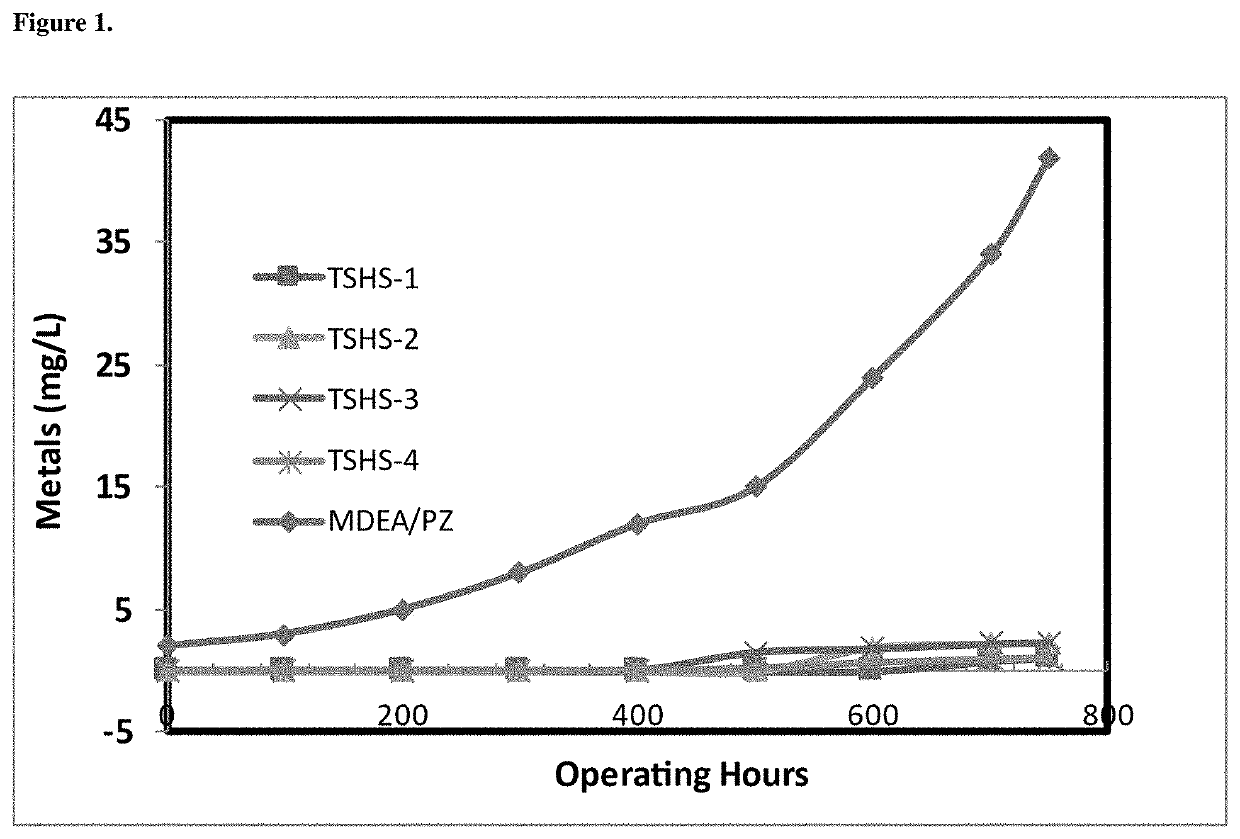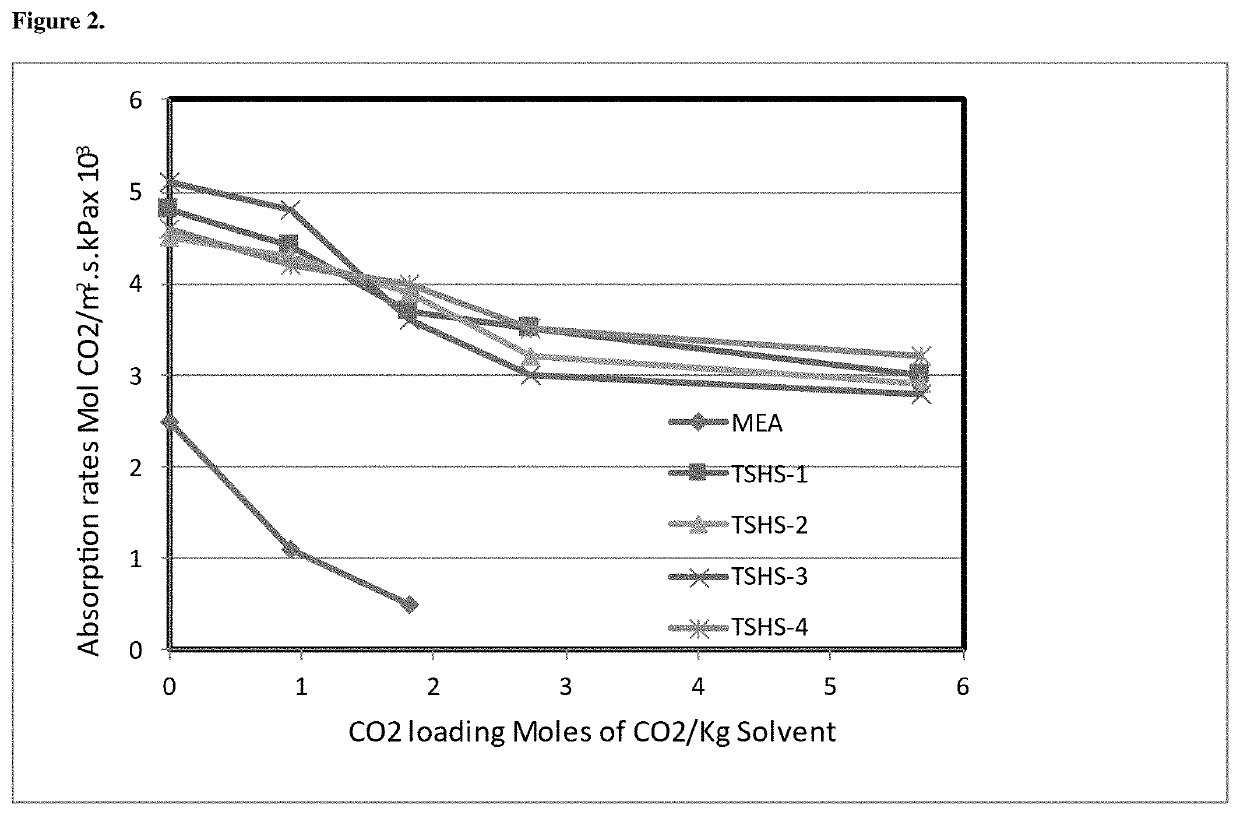Solvent composition for co2 capture and a process mediated thereof
a technology of co2 capture and solvent composition, applied in the field of energy and environmental sciences, can solve the problems of low cosub>2 /sub>loading capacity of the solvent, huge energy requirement for solvent regeneration in the stripper, and the disadvantages of conventional solvents, so as to achieve the effect of less energy and increased carbon capture efficiency
- Summary
- Abstract
- Description
- Claims
- Application Information
AI Technical Summary
Benefits of technology
Problems solved by technology
Method used
Image
Examples
example 1
of TSHS-1 Solvent
[0073]a) To synthesize TSHS (1 L) first the base solvent was prepared by mixing 240 g of 2-amino-2-methyl-ipropanol and 60 g of 2, 4-diaminoethylbenzene was properly mixed for 4 h at room temperature.[0074]b) In another vial 100 mg of methyl prolinate was dissolved in 5 ml of DI, The solution was added to the mixed amine prepared in ‘step-a’ at a rate of 0.2 ml / min with constant stirring at 230 rpm followed by addition of Poly(ethylene glycol) linear dendrimer (30 mg) drop wise. The resulting solution was stored at 30° C.[0075]c) Synthesis of colloidal Zn-covalent metal-organic compound: A stock solution of Zinc chloride was prepared by dissolving Zinc chloride (0.9 mmol) in 30 mL of N, N Dimethylformamide (DMF). A second stock solution comprised of terephthalic acid (3.01 mmol) in 10 mL of DMF was prepared. Zinc chloride stock solution (3 mL) was added to terephthalic acid stock solution (1 mL), 20 mg F-127, and 10 mg poly(ethylene) glycol in a 10 mL vial. 1.5 M fo...
example 2
of TSHS-2, 3 & 4 Solvents
[0081]Three other solvent systems were synthesized in the similar way as for TSHS-1 in Example 1 above, having the following composition as given in Table-2. The concentration, rate of addition and condition are similar for all the synthesized solvent.
TABLE-2Preparation of TSHS solvent system with various compositionSolventTSHS-1TSHS-2TSHS-3TSHS-4Alkalomine or2-amino-2-2-amino-2-2-amino-2-2-amino-2-hindered aminemethyl-methyl-methyl-methyl-ipropanolipropanolipropanolipropanolHindered aromatic amines2,4-diaminoethylbenzene2,4-diaminoethylbenzene2,4-diaminoethylbenzene2,4-diaminoethylbenzeneProlinate derivativesMethyltert-Butyltert-ButylMethylProlinateL-prolinateL-prolinateProlinateIntermediate stabilizerPoly(ethylene glycol)Amine-PolypropyleniminePolypropyleniminelinear dendrimerterminatedDendrimersDendrimersPEG-coreDendrimersGlycol derivativesPoly(ethylene glycol)Poly(ethylene glycol)Poly(ethylene glycol)Poly(ethylene glycol)CCMOZn-CCMOZr-CCMONi-CCMOZn-CCMOS...
example 3
ization of TSHS Solvent and Methods of Measurement
[0082]1. Carbon Dioxide Absorption by Gravimetric Analysis
[0083]Gravimetric analysis: For CO2 absorption measurements (time-dependent CO2 uptakes of TSHS) of the TSHS, CO2 gas was flown into a reactor (100 mL) containing 20 g of solvent at a flow rate of 20 mL min−1. The weight percent of CO2 absorbed was determined by weighing the solvent at a regular interval using an electronic balance with an accuracy of ±0.1 mg.
[0084]2. CO2 Solubility Analysis Continuous Flow Bubbling Reactor
[0085]CO2 solubility was measured using a continuous flow bubbling reactor (CFBR). The CFBR can be operated in various pressure modes. Gas cylinders with different CO2 mole fractions from 400 ppm to 90% were connected to the feed line of the reactor through individual mass flow controllers. A glass vessel with a solvent capacity of 50 mL was used as the reactor. The reactor temperature was maintained constant using water circulating between the reactor jacke...
PUM
| Property | Measurement | Unit |
|---|---|---|
| Temperature | aaaaa | aaaaa |
| Temperature | aaaaa | aaaaa |
| Temperature | aaaaa | aaaaa |
Abstract
Description
Claims
Application Information
 Login to View More
Login to View More - R&D
- Intellectual Property
- Life Sciences
- Materials
- Tech Scout
- Unparalleled Data Quality
- Higher Quality Content
- 60% Fewer Hallucinations
Browse by: Latest US Patents, China's latest patents, Technical Efficacy Thesaurus, Application Domain, Technology Topic, Popular Technical Reports.
© 2025 PatSnap. All rights reserved.Legal|Privacy policy|Modern Slavery Act Transparency Statement|Sitemap|About US| Contact US: help@patsnap.com


